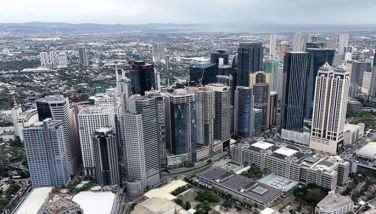Fix the bus system first

Here is one more internationally recognized Filipino transportation expert expressing an idea that makes sense. Government bureaucrats and their consultants have been talking about doing an expanded rail system as the solution to our mass transport woes. But not only do rail systems cost a lot of money, rail solutions also take a long time to put in operation.
In the meantime, we have all those buses already in service, clogging EDSA often with less than half their total number of seats occupied even during rush hours. Because the bus drivers operate on a boundary system like the jeepney drivers, there is this mad rush to get passengers even if traffic rules are violated in the process.
What if, as I suggested in a previous column, we took all those buses and converted them into a bus rapid transit system with a designated lane they cannot leave? What if we placed the drivers on a salary basis and a schedule to be at certain pick up points at very specific times?
Of course I am dreaming. But wait, I have seen systems like this in many world capitals. The last city where I saw a functioning bus rapid transit system working is Urumqi in Xinjiang province in China. That’s supposed to be China’s frontier area, yet the city’s mass transport system is light years more civilized than ours.
Last Wednesday, I read this article in InterAksyon by Benjamin dela Pena, a transportation systems consultant for the Rockefeller Foundation in New York. His article drove home the simple point that DOTC and their JICA experts have not seen. Dela Pena says we need rail, but rail will not replace the bus.
Doing something about our buses cannot be ignored even if we go on and invest a bundle on those long gestating rail projects. Here is a very basic point Dela Pena raised that everyone seems to have missed: “Building a new, extensive rail system may take us a decade or more. Reforming the bus system can be done much, much more quickly.
“We can build extensive and high quality bus rapid transit (BRT) and bus feeder services in less than two years. We can reform the bus value chain in one year. It can be done. Our sister megacities have shown the way.”
Dela Pena cites the example of Bogota. “Enrique Peñalosa opened the first phase of Bogota’s Transmilenio BRT system within three years of the inception of the project. Construction took less than a year.”
Closer to home is Seoul. Dela Pena recalls that “in July of 2004, responding to a transportation crisis, Seoul launched its bus transit reform program that completely restructured the bus service across their megacity. Among the changes, payments were taken electronically. Private bus services were paid directly by government for the kilometers they served, not the number of passengers they carried.
“The chaos of the shift only lasted for three months. By October of the same year, 90 percent of the Seoul residents expressed satisfaction with the radical reforms.”
Dela Pena noted that “the description of Seoul’s bus system prior to reforms sounds very familiar… Most of the private bus firms sought only to maximize profits (or minimize losses) while disregarding rider safety and comfort… Bus drivers would recklessly race other buses to pick up passengers waiting at bus stops… bus vehicles were old, poorly maintained, and did not meet international standards. Service was dangerous, slow, uncomfortable, and unreliable.”
I share Dela Pena’s lament that we have yet to hear the DOTC talk about improving the bus service. “We passed (watered-down) regulations requiring salaries for bus drivers after realizing that reckless bus driver behavior was driven by the feudal boundary system.
“We’re building multi-modal stations to keep provincial buses off EDSA but in so doing, create more problems for the commuting public. We paint extra large numbers and color-code the buses but this is just to make it easier for traffic managers to identify the buses. We even proposed installing RFIDs to enable electronic identification of buses.”
But, Dela Pena pointed out, “none of the above solutions have anything to do with improving the user’s experience of bus service. None of them will make public transportation safer, faster, more efficient or more reliable. None of them will improve the quality of life of our citizens. None of them will encourage private car owners to take the bus.”
Dela Pena says our problem is not a technical one… it is political. And I think he is right. We have been talking about doing something about the jeepneys and buses but stop short of doing anything on the ground because of politics.
We can’t even take action against the buses with no franchises or out of line, the so called colorum buses. The scuttlebutt is current government officials don’t have the political will to go against the retired police and army generals and their mistresses who own those buses. Dealing with the jeepneys even if only to take the worst offenders of our air pollution laws is also so politically sensitive it never gets done.
Dela Pena makes sense. That MRT7 from EDSA to San Jose del Monte in Bulacan which took over ten years to get a go signal from government could have happened faster if a BRT was proposed instead.
There is a proposal to put up a BRT service in the MOA area whose route would be from Vito Cruz near the Cultural Center to MOA or even Baclaran. No such service is being provided yet. But with call centers in the area, there is a clear need for the service.
The curious thing here is that the new service is not going to replace any existing one so the political problem is non existent. Yet, DOTC has not considered it enough to even talk with the proponents.
Dela Pena makes a good point in saying that the approach of our transport officials are “just more tired ways of trying to solve traffic congestion which is the wrong problem to solve.” The key word he said, is service and the solutions so far have nothing to do with improving the actual service.
“We can find the solutions if we set our priorities right. And with a super majority of Metro Manilans dependent on public transportation – 8 out of every 10 – our politicians should need no other reason to get things done… If we want rapid relief from our transportation woes, we have to do radical work on the bus.”
In any case, he cites data to show that even in cities where the rail system is quite developed, buses still carry most of the commuter load. “According to the latest numbers from Transport for London, their city’s iconic Underground (402 kilometers long) served 1.2 billion passenger trips from 2013 to 2014. But London’s buses served double that number with 2.4 billion passenger trips.
“Similarly, Hong Kong has more than 210 kilometers of heavy and light rail and yet 55 percent of Hong Kong residents take the bus. Only a quarter use rail. Taipei has over 120 kms of rail that carry 14 percent of the mode share, while Taipei buses carry 18 percent. In Singapore, the mode split is 25 percent for bus, 19 percent for rail. In Guangzhou, it’s 35 percent for bus, 14 percent for rail.”
He ends with a quote from Enrique Peñalosa, former mayor of Bogota and global champion of BRT: an advanced city is “not where the poor move about in cars [but] where even the rich use public transportation.”
That will be the day when Metro Manila’s elite are commuting on mass transit together with everyone else.
Historical
JUAN: Bakit ang mga mrs pag nang-away lagi HISTORICAL?
MAX: Baka ibig mo sabihin HYSTERICAL?
JUAN: HISTORICAL kasi INUUNGKAT ni mrs mga kasalanan ko!
Boo Chanco’s e-mail address is bchanco@gmail.com. Follow him on Twitter @boochanco
- Latest
- Trending



























